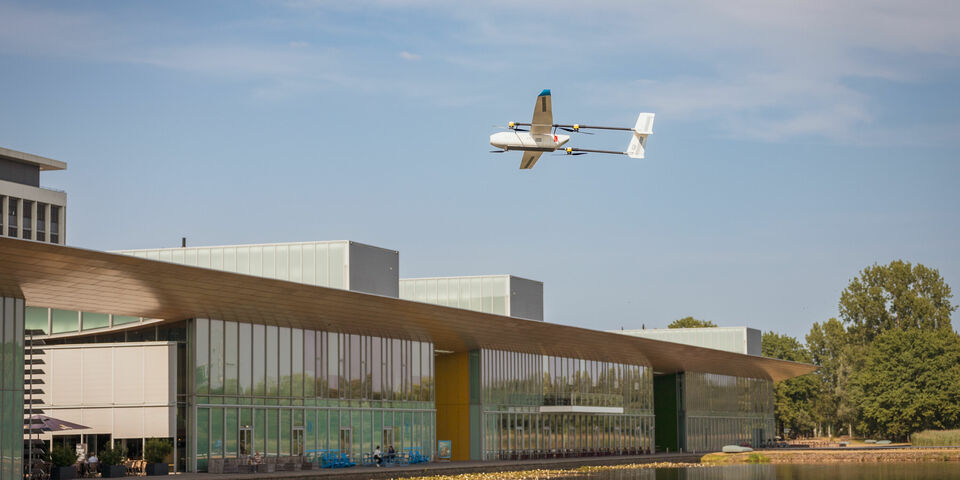Cargo drone Aegle flies across pond and then...
Aero Team Eindhoven yesterday presented the Aegle, a 3D-printed drone with a 3 m wingspan designed with the ultimate aim of delivering parcels to people's homes. This is the student team's first milestone. Under the gaze of the public gathered on the High Tech Campus, Aero put its drone to the test, flying it out over the lake. For three circuits all went well before a gust of wind proved too much of a challenge for one of the four engines.
Before team Aero sets about demonstrating its Aegle, the nearly three hundred guests gather in the Einstein room. Here, Madis Tamar, program manager of TU/e’s student teams, tells what the teams can achieve “in residential neighborhoods, on roads, in space” with their non-commercial, interdisciplinary, extra-curricular approach. Next, Bart Wernaart in his capacity as lector of Moral Design Strategy at Fontys talks about the ground covered by his research on the ethical aspects of drones.
Aero’s team manager Bram Schut looks back on the choices Aero has made: “Drones are already being used for security purposes, to inspect wind turbines and other tall buildings, and to make deliveries. Thanks to the Urban Air Mobility Hub, the High Tech Campus has become a testbed for drone projects. Aero is focusing on 'last mile delivery'. Drones offer many advantages over road transport, but battery life is still a problem. It takes too long to recharge a battery and so we want to switch out the battery. In the air, because it's the take-off that drains power.” Team Aero wants to develop the world's first aerial battery-swap system, to enable infinite flying hours. ‘Aegle will become the first piece of the jigsaw', as the team's press release announces.
Revolutionary parcel service
Today, the team members are demonstrating that first piece of the jigsaw: a winged drone that can take off and land vertically. We walk down to the lake and see the team complete the lengthy task of calibrating the Aegle. It has been printed in Lightweight PLA and weighs ten kilos. Carrying a cargo of two kilos, this prototype can stay aloft and mobile for 18 minutes, if all goes well. With its three-meter wingspan, it has great stability. And there is a sizeable landing platform for future battery deliveries.
The Aegle can reach speeds of up to 80 km/hr. But speed and range are not the team's highest priorities; their focus is on flight stability. "Speed and range aren't that important to us. What's particularly important for this project is that we get the drone flying with as much stability as possible, so that we can land a second drone on it," explains technical manager Grant van Vuuren.
Wet landing
Fifteen minutes later the audience is asked to stand back behind the red line. “Aero is ready for take-off. Stay safe and have fun,” says team member Zach Kohnen. While the weather is sunny, it isn't windless. Aero takes off and guided by the controller, operated by Harsh Nagouda, this impressive behemoth flies serenely out over the lake. Three circuits go well. As Isa Dantuma is saying, “It's nail-biting to watch, but I've got every confidence,” a gust of wind upends the Aegle. It crashes into the water, in the middle of the lake. Without a moment's hesitation, three students dive into the water to retrieve the wreckage. A hush falls over the onlookers.
Costly exercise
The team remains positive. “We have proved that it's possible. But this prototype can't yet withstand a gusting headwind. That's what caused one of the four engines to shut down,” says the team manager. “But we have spare parts and in three days' time we'll be ready to carry out new tests.” The only part that looks damaged is the tail, but replacing the electronics will be a costly exercise running into thousands of euros.
Pilot Nagouda sees the upside of the drone smacking into the water. “It was lucky it didn't happen among us here on dry land. The propellers rotate eight to nine thousand times a minute. It would have been very hazardous having pieces of wreckage flying around.” A test can fail, it's all part of the process. Among the team members this is the general consensus.
And onwards!
During his internship with Aero, Ties Aben, a mechatronics student at Fontys, has come up with a locking system, and at a lakeside stall he demonstrates how it works. “It has been inspired by the way in which dragonflies grab hold of each other. I’ve printed off saddled-shaped pieces that fall easily into a stack. Then the claws grasp one another. A QR sticker on the cargo drone can be used can activate this at the right moment. The swap drone has a camera that interprets the code remotely and at an angle.”
The coming milestones in Team Aero Eindhoven's four-year road map are these: the presentation of the Spaerow, the hook-up between Aegle and Spaerow, and the ‘first ever aerial battery-swap’. This coming academic year will see the construction of the Spaerow, the drone that in time will be responsible for switching out the Aegle's battery in-flight.








Discussion